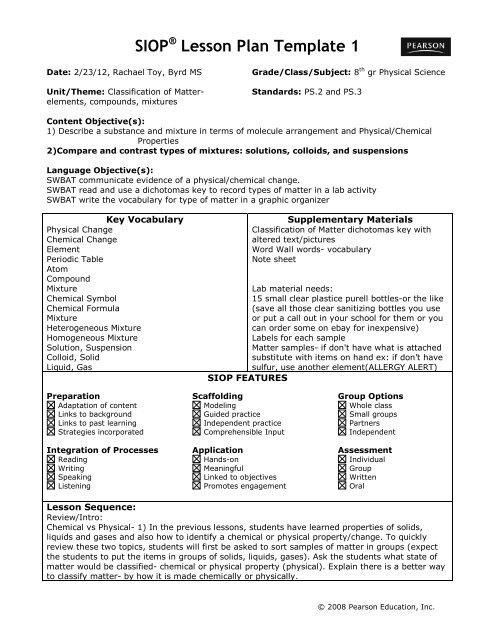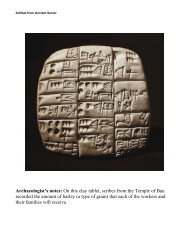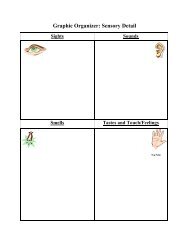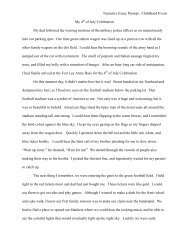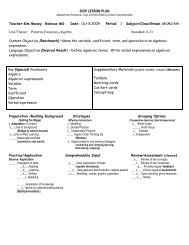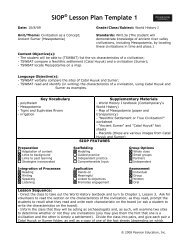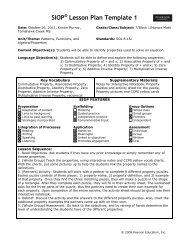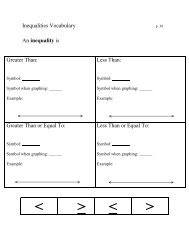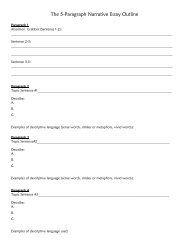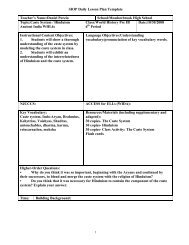SIOP® Lesson Plan Template 1 - ACT-ESL
SIOP® Lesson Plan Template 1 - ACT-ESL
SIOP® Lesson Plan Template 1 - ACT-ESL
- No tags were found...
You also want an ePaper? Increase the reach of your titles
YUMPU automatically turns print PDFs into web optimized ePapers that Google loves.
SIOP ® <strong>Lesson</strong> <strong>Plan</strong> <strong>Template</strong> 1Date: 2/23/12, Rachael Toy, Byrd MSUnit/Theme: Classification of Matterelements,compounds, mixturesGrade/Class/Subject: 8 th gr Physical ScienceStandards: PS.2 and PS.3Content Objective(s):1) Describe a substance and mixture in terms of molecule arrangement and Physical/ChemicalProperties2)Compare and contrast types of mixtures: solutions, colloids, and suspensionsLanguage Objective(s):SWBAT communicate evidence of a physical/chemical change.SWBAT read and use a dichotomas key to record types of matter in a lab activitySWBAT write the vocabulary for type of matter in a graphic organizerKey VocabularyPhysical ChangeChemical ChangeElementPeriodic TableAtomCompoundMixtureChemical SymbolChemical FormulaMixtureHeterogeneous MixtureHomogeneous MixtureSolution, SuspensionColloid, SolidLiquid, GasSupplementary MaterialsClassification of Matter dichotomas key withaltered text/picturesWord Wall words- vocabularyNote sheetLab material needs:15 small clear plastice purell bottles-or the like(save all those clear sanitizing bottles you useor put a call out in your school for them or youcan order some on ebay for inexpensive)Labels for each sampleMatter samples- if don't have what is attachedsubstitute with items on hand ex: if don’t havesulfur, use another element(ALLERGY ALERT)SIOP FEATURESPreparation Scaffolding Group OptionsAdaptation of content Modeling Whole classLinks to background Guided practice Small groupsLinks to past learning Independent practice PartnersStrategies incorporated Comprehensible Input IndependentIntegration of Processes Application AssessmentReading Hands-on IndividualWriting Meaningful GroupSpeaking Linked to objectives WrittenListening Promotes engagement Oral<strong>Lesson</strong> Sequence:Review/Intro:Chemical vs Physical- 1) In the previous lessons, students have learned properties of solids,liquids and gases and also how to identify a chemical or physical property/change. To quicklyreview these two topics, students will first be asked to sort samples of matter in groups (expectthe students to put the items in groups of solids, liquids, gases). Ask the students what state ofmatter would be classified- chemical or physical property (physical). Explain there is a better wayto classify matter- by how it is made chemically or physically.© 2008 Pearson Education, Inc.
SIOP ® <strong>Lesson</strong> <strong>Plan</strong> <strong>Template</strong> 12) Students will then view two demonstrations. On their white boards, students will recordproperties or evidence they observe to identify it as a physical or chemical change. Discuss as aclass the results and how we can use what we observe to classify matter in this new way. (Iwould recommend doing food coloring in water then evaporate the water to leave the color solidbehind- for chemical you can do simply baking soda and vinegar in a bag - it gets cold andinflates the bag OR you can do H2O2 decompose using MnO2 to produce O2 and relight a woodsplint.)<strong>Lesson</strong>:How do we classify matter by identifying if it was made chemically or physically? Post thisquestion up on the board for all students to see.Activity:1)Students will use a Dichotomous key to classify matter as an element, compound or mixture.The lab works best in groups of 4 with students working in pairs. Each student will need a PeriodicTable, recording sheet and a dichotomous key. Explain that dichotomas means to cut (Di) orclassify- make into groups like we did earlier. Classify #1 Air as a class to help students learn touse the key to identify. Do this by taking students through the key. Students will record theactual sentence from the key onto their sheet along with the name of the classification. (See Key)Students record the sentence from the key to the table along with the word to identify thematter. Rotate samples two at a time around the room until all groups have identified thesamples. Suggested time of 4 minutes or less to identify.SAFETY ALERT: THIS <strong>ACT</strong>IVITY CALLS FOR SULFUR. SOME STUDENTS MAY NOT BE ABLE TOHANDLE DUE TO ALLERGIES. BE SURE TO BE CLEAR TO STUDENTS TO NOT OPEN, SMELL ORINGEST ANY OF THE MATERIALS IN THE BOTTLES.(DEMONSTRATE THIS VERY CLEARLY)2) Once all samples have been rotated, students will put the name of the sample into the graphicorganizer. Point out to students that there are only enough boxes for that number of correctlyidentified samples. If they have too many or too few under a category, they should go back andreuse the key to correct.Discussion:Discuss the matter that fell in each category and what they have in common. Students will fillout the notesheet and draw what the sample is like as the terms are discussed. If appropriate forthe group- you may even want students to try coming up with their own definitions from whatthey see in their classifications. Use the PPT to organize your discussion. Have students drawinterpretations of what the matter would look like on the molecular level(this could also be a hwassignment and followup to the next class)Alternative technology- If you have a smart board or Promethean board, you may want to make aflipchart where students can classify the matter physically at the board as a check.Wrap up: Play the Who has, I have game with the new vocabulary cards: Print the game wherevocabulary is on one card and definitions are on another. Pass out randomly. Students then readwhat is on the card and the person with the matching vocab word or definition will read theirs.You may want to have pictures for each.Assessment: Have students classify 7 samples of matter using their organizer and lab. Turn in asthey leave class.HW: Have students cut out and paste pictures of matter onto their organizer.Reflections:© 2008 Pearson Education, Inc.
SIOP ® <strong>Lesson</strong> <strong>Plan</strong> <strong>Template</strong> 1(Reproduction of this material is restricted to use with Echevarria, Vogt, and Short, 2008. Making ContentComprehensible for English Learners: The SIOP ® Model.)© 2008 Pearson Education, Inc.


